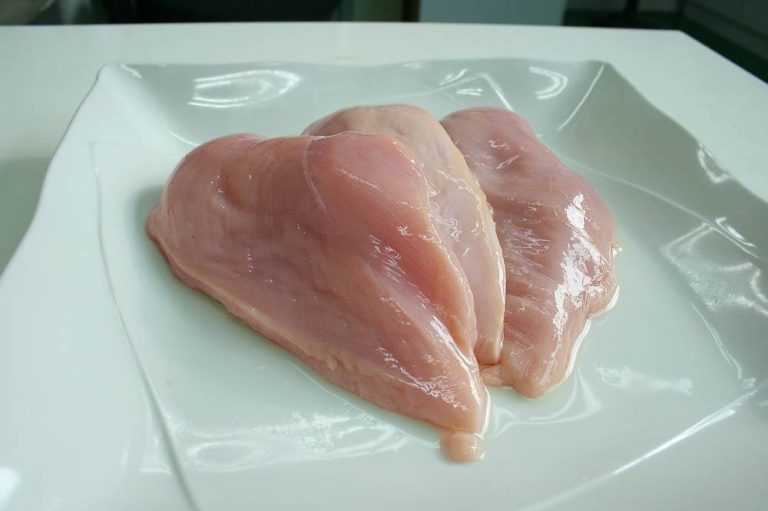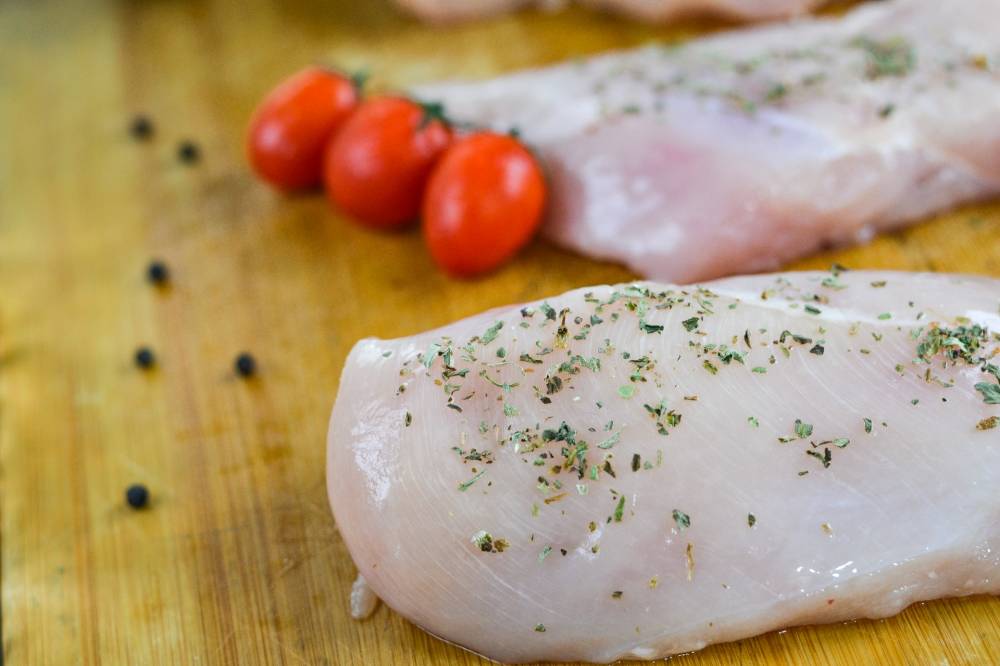Chicken breast is an all-time favorite food for many Americans. Research shows that 57% of chicken consumers go for breasts, followed by thighs at a 12.9% consumption rate.
But as much as we love eating breasts, measuring and cooking them is tricky, especially if you don’t know how to approximate their weight.

Our question today is, ‘How many chicken breasts in a pound? Two eight oz. Breasts of boneless chicken breast make one pound of meat.
In this article, we will measure, cook and serve chicken breasts.
As a bonus, we’ll include a nutritious and healthy recipe that will forever make your kitchen a wonderful place.
Related Post: How much are 3 ounces of chicken breast?
How Many Chicken Breasts Is 1 Pound?
There is no exact answer to this question since breasts are unique to the chicken they came from, but we will use our best expertise and knowledge to help you estimate.
Generally, two eight oz. Breasts of boneless chicken breasts make one pound of meat. However, when we talk of cooked meat, things are slightly different.
As we all know, cooking drains out water from meat; thus, the aggregate weight will reduce by a certain percentage.
A well-cooked chicken breast loses 25% of its water; therefore, to make a pound, you will need half a breast, totaling two and a half breasts.
How Many Chicken Breasts Equals 2 Lbs.?
Four boneless raw chicken breasts are equal to 2 lbs. This is also equivalent to 5 cups of diced chicken breasts.
But, after cooking, to get 2 pounds of boneless breasts, use five raw breasts. This will ensure your family receives the correct quantity of food for a proper balance of nutrients.
How Many Pounds Are Two Boneless Chicken Breasts?
Two boneless chicken breasts make one pound of meat. Similarly, two boneless breasts can feed a family of two to four people in one go.
What Do Eight Chicken Breasts Weigh?
From our above findings, the average weight of a raw boneless chicken breast is 0.5 lbs. So to find out how many pounds 8 chicken breasts are, we shall multiply eight by 0.5 to get 4.
Thus eight medium-sized breasts are equal to 4 pounds of meat.
How Much Do Four Chicken Breasts Weigh?
Similar to the above answer, to find out how much four chicken breasts weigh, we shall multiply the number by 0.5 (the average weight of a single breast).
This will give us two, so four chicken breasts equal two pounds of meat.
How Many Boneless Chicken Breasts Are In A Pound?
If you have been carefully reading through our article, there is a high chance that you already know the answer to this question. But let me explain to clear the air.
Two boneless chicken breasts are equal to one pound of meat. Cooking them with salads and side dishes can make a sizable meal to feed more than two people at a small dinner party.
Which Is Healthier: Chicken Breasts Or Thighs?
The ever-active debate on which part of the chicken is healthier or sweeter can never cool down without mentioning chicken breasts and thighs.
Breasts are healthier due to the level of unsaturated fats they contain, but they come at a slightly higher price.
In contrast, chicken thighs are cheap, tastier, and juicier, making them a reliable source of protein for many American households.
But with every bite from a thigh, you ingest more unsaturated fats, and unhealthy cholesterol builds up in your system despite it being white meat.
Here is a complete breakdown of what a chicken breast and thigh contain regarding nutritional value.

A 4-ounce or 113g chicken breast provides at least 130 calories, a gram of saturated fats, and three grams of fats. 113g of thighs, on the other hand, have 170 calories, 3 grams of saturated fats, and 49mg of cholesterol.
Though calculating the actual nutrition value of every thigh and breast is complicated since we usually cook them with many seasonings and toppings, we can always gauge.
From our above scientifically proven results, breasts are healthier compared to thighs.
Experts’ Advice On Chicken Breasts
Research done by American Journal for Clinical Nutrition shows that poultry’s cholesterol has surprisingly similar effects to beef’s.
Therefore, we should always go for chicken parts with less fat and cholesterol content, such as breasts, for a healthy body.
Healthy Roast Chicken Breast Recipe
Despite chicken breasts being one of the healthiest combinations of go-to American meals, their preparation plays a vital role in the final results.
In our hearty recipes, we have devised a unique way to make a simple chicken breast into a thousand-dollar dish loaded with many flavors. Here is how we do it.
What You Need:
- One pound of boneless chicken (approximately four breasts)
- A cup of pure olive oil A tablespoon of paprika (mild, sweet, or smoky) for a deep red or orange color and enhanced taste
- A tablespoon of oregano or thyme, depending on your preferences
- Two tablespoons of brown sugar for an extra sweet savor
- A tablespoon of onion powder
- A tablespoon of garlic powder or four medium-sized minced garlic cloves
- A few tablespoons of salt
- A pinch of ground pepper
Procedure:
Step 1: Prepare The Chicken
Brine your chicken in warm water and salt for at least 20 minutes. Brining enhances its natural flavors, moistens, and softens it for a shorter cooking time.
To do this, three cups of water with three tablespoons of salt.
Step 2: Marinate Your Chicken With Food Seasonings
After you are done with bringing, dry the breasts using a towel and amply season them. Here, you will lightly brush olive oil on your meat, followed by a proper massage of food seasonings.
Mix paprika, oregano, brown sugar, onion powder, garlic powder, salt, and pepper in a small bowl and rub them on your chicken.
Chef’s tip: If your breasts are so thick and uneven, use a mullet to even and soften them. You can also use a small source pan to pound the meat for a uniform and faster cooking rate.
Step 3: Roast The Meat On A Grill
This is our main concern, where the dish is only some minutes away. Roasting the meat on high heat, approximately 392°F, makes them crispy on the outside while preventing the moisture inside from escaping.
Do this for 2 minutes on one side and repeat the process on the other side of the chicken breast.
Other than creating a crispy layer, roasting adds a smoky flavor. You can also adjust the roasting time to achieve a dark brown coat.
Step 4: Finish Off The Chicken Breasts In An Oven
Transfer the partially grilled chicken to a baking dish and finish the cooking in an oven.
For this, set your oven at 439°F and bake the meat uncovered for 16 minutes or until its internal temperature reaches 165°F.
Pro tip: At 165°F, the meat is safe and savory; it is not challenging or undercooked. Increasing the past temperature to 170°F dries and hardens the beef, and serving it before it reaches the 165°F mark renders it susceptible to meat-borne diseases.
Check out more information on optimum cooking temperature here.
Step 5: Let The Meat Rest For A While
We know you are salivating and eager to taste our home-roasted chicken breasts, but be patient a little longer.
Give your well-roasted and baked chicken five minutes of quiet time to let the juices redistribute in the meat fibers.
Resting also prevents juices inside from spilling out after cutting your breasts.
That is it! Serve these juicy and tender breasts with your favorite side dishes and a wealthy combination of salads.
Conclusion
We have approximated that two chicken breasts equal one pound of meat cooked and served.
We’re yet to scratch the surface of a cooking sphere; we shall be posting more information soon.



